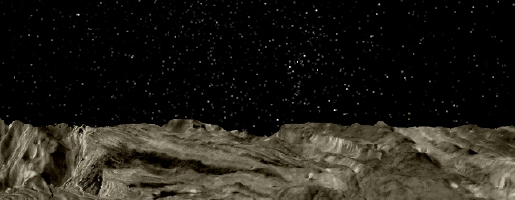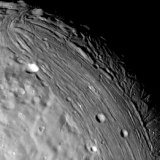 |
|
|
Orion
rising over Miranda's horizon.
|
|
| THE INTERIOR OF MIRANDA | |
| Miranda, at first glance, appears to have had a very disturbed history. For a long time the favoured account of its evolution described repeated shattering by meteorite impacts. These blew Miranda apart. After each impact it re-formed from the debris. Chunks of the moon's former interior became exposed alongside older (cratered) surfaces which had survived. | |
| The surface is not quite what we would expect to see if this was what really happened. Some of Miranda's most prominent banded ridges are thought to be the exposed layers of an earlier interior. These are very straight. If Miranda had been blown apart and re-formed into a sphere the layers would have deformed. | |
 The ridges and grooves of Elsinore Corona, and the bright crater Stephano. |
|
| Another theory is that large chunks of sinking material disrupted the interior. Very dense rock fragments sinking through the viscous (sticky) surface layers pulled material with them as they went. In response, the uppermost layers moved inward, dragging the surface of the crust with it and compressing it into a series of ridges. | |
| The currently favoured hypothesis is less dramatic, but probably nearer the truth. The ridged and grooved terrain looks very similar to the sulcus terrain of Ganymede and could well have formed in the same way. Liquid water erupted from cracks and froze to form ridges. The trends observed are explained by movement of the surface. | |
| Miranda's proximity to Uranus may have generated enough tidal heating to sustain a molten interior. If the interior was molten, then volcanic processes could well be responsible for the grooved terrain. Upwelling of warm low-density blobs, like coronae on Venus, may have fractured the surface paving the way for ridge formation. | |
|
|
|